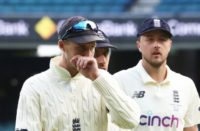In Richard Ford’s elegiac novel The Sportswriter, the protagonist Frank Bascombe reckons there is “nothing as noble and enduring as the willingness to come off the bench to play a great game knowing full well that you’ll never be a regular”.
Bascombe was talking about the baseball he watched and wrote about, but the sentiment could have applied across most sports before satellite TV brought about a wages bonanza. Indeed, players on the fringes back then probably deserved our sympathy, suffering as they did the frustrations of being the ‘nearly but not quite’ men. But that has changed, at least in cricket, with central contracts now offering a comfort zone which leaves the man on the margins with few incentives to escape his predicament.
Take Steven Finn, England fast bowler and 28 years old next month. Finn began his Test career with great promise seven years ago, but has not really trained on. Indeed, if truth be told, he has probably stagnated, something which may have as much to do with the safety net of his £700,000 a year central contract as the myriad, sometimes conflicting, advice he has received on how to bowl quick.
I’m not blaming him, particularly. His response of just doing enough to stay in the mix is fairly standard human behaviour. Sure, he would get paid extra – £12,000 a game more for each Test he played – if he was a regular, but whereas he once complained bitterly whenever he was dropped, his agitating seems to have stopped and with it the ambition to improve year upon year to become England’s leading new-ball bowler.
It could be that he is playing a waiting game, biding his time for James Anderson or even Stuart Broad to call it a day over the next 18 months. But that would be a dangerous tactic and not just because fast bowlers like him tend to decline rapidly once they reach 30 (he may prove the exception as he has scarcely endured the workload of predecessors like Angus Fraser or Essex’s Neil Foster).
The main risk, other than Anderson and Broad going on, is that other bowlers improve to provide extra competition, something Chris Woakes has done to the point where he has now moved above Finn in the pecking order. Behind Woakes, other tyros are lining up like the Overton brothers, Jamie and Craig, as well as the likes of Tom Helm and Toby Roland-Jones, the last two Middlesex teammates of Finn’s. All have been busy lately increasing their know-how on the Lions tour to Sri Lanka, a tough place to bowl anything above medium pace.
I like Finn as both bowler and person, but with seven years involvement in England squads, and standing 6ft 8ins tall, he should really have been established in the Test side by now as something special. Instead, he has endured a number of setbacks, the worst of them when Ashley Giles, then England’s one-day coach, deemed him “not selectable” during the Ashes tour three and a half years ago.
Promise can take you so far before your backers demand a solid return, though Finn seems lucky in that regard. In 2016, he took just 17 wickets in nine Tests, a haul the selectors somehow deemed good enough to warrant a central contract worth £700,000. Of course Middlesex, while happy to have him knock over county batsmen, don’t want him back on their pay roll, but you can see how a season back on county gruel might have provided an added incentive for him to up his game.
Curiously, it seems to be bowlers more than batsmen who list about on the fringes. With batsmen, the selectors seem to give them a run in the side then either stick with them for a while or drop them for good. Exceptions to that are Mark Ramprakash and Ravi Bopara, though Ramprakash was pretty much done by the time central contracts were introduced during 2000. Still, over an 11-year England career, he managed to play 52 Tests, unthinkable now given that his average was just 27.3, a number barely acceptable when pitches were open to the elements let alone covered as they were during his career.
Bopara averaged 31.9 with three Tests hundreds (one more than Ramprakash) from 13 Tests, but looked out of his depth apart from one starburst against the West Indies which saw him make those three hundreds in successive Tests against them. A chaotic private life did not help his cause though, neither did the lure of the Indian Premier League, except to act as a disincentive to fight to regain his place in England’s red ball team.
In some teams like the West Indies, the plethora of T20 leagues now active have prevented first choice Test players, let alone fringe ones, from representing their countries. Ironically, central contracts have mostly protected England’s players from the siren call albeit by offering them the same financial security from the uncertainties of improving one’s game.
Sometimes it does not appear to be the player’s fault at all that they don’t become regulars, such as the curious case of Ryan Sidebottom.
A fine left-arm swing bowler, Sidebottom played one Test for England against Pakistan at Lord’s in 2001 (when Duncan Fletcher was head coach). He failed to take a single wicket and then didn’t play for England again until 2007 when he enjoyed a good run in the side under coach Peter Moores. Then, almost as quickly as he arrived, he was gone again, England’s new coach, Andy Flower, seeing something in him that did not fit with his plans despite Sidebottom’s way with a swinging ball.
Having gone from being a fixture in the side at the the age of 31 to bidding England a final farewell at 32, it was a rapid decline for Sidebottom – something Finn needs to take note of if he is not to run out of time before making good on that early promise.
This piece originally featured in The Cricket Paper, March 17 2017
Subscribe to the digital edition of The Cricket Paper here












